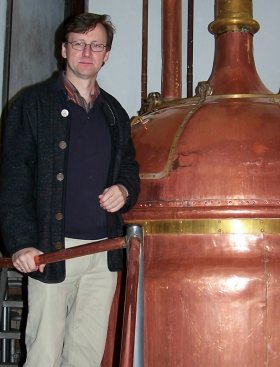| |
A new look at lager
by Willard Clarke, 07/07
Lager is often described as the beer of the industrial age. The widely held view is that cold fermentation and storage - lagerung in German - was made possible on a commercial scale only with the invention of
ice-making machines in the 19th century by Carl von Linde.
Refrigeration, it is thought, was the giant step forward. It enabled the great Munich brewers, including Lowenbrau, Paulaner and Spaten, to brew beer for a mass audience that included the emerging
industrial working class. Then in 1842 came the golden revolution in neighbouring Pilsen when the first pale lager from the Citizens' Brewery - now Pilsner Urquell - took the world by storm. With the
exception of the British Isles, brewing has never been the same since.
In fact, the use of the lager method is much older. It has been known for some time that for centuries before the industrial revolution some brewers - including monastic ones - had stored beers in caves in the
Alps to avoid infection from wild yeasts and torrid summer temperatures. The brewers noticed that the natural cool temperatures in the caves encouraged a much slower second fermentation and maturation.
Empirically, "bottom fermentation" had been discovered.
But now it seems the method of storing beers in caves and cellars in medieval times was more far-reaching, as a visit to Nuremberg and Bamberg in Franconia - northern Bavaria - proves.
Nuremberg stands on a labyrinth of cellars that are 600 years old. The Hausbrauerei Altstadthof - literally, the House Brewery in the Old Town Courtyard - has been brewing since 1386 and the current owner,
Reinhard Engel (right), uses a section of the deep, natural cellars to store some of his beers. With the exception of a wheat beer, all Reinhard's beers are lagers. They include a pale Helles, a red Roth, a
black Schwarz and a strong Maibock. Helles, Red and Black are lagered for two months, the bock for three.
When I suggested to him that before the 19th century the brewery must have produced only warm-fermenting beers, he looked puzzled. "The brewery has always lagered its beers," he said emphatically.
|
|

|
"They were stored in the cellars." He proved the point with a tour of the caves beneath the brewery where he stores bottled versions of his stronger lagers, including spring and winter bocks. He stored one
bock for more than two years.
In both Bamberg and Nuremberg, the citizens dug into the sandstone rock on which the cities were built. They needed the rock for building houses, churches and cathedrals, and also as an abrasive cleaning
material. The cellars left behind - some of them can be walked in to from the street - were used to store perishables, beer as well as food. On a smaller scale, the British, before the arrival of refrigerators after
World War Two had larders in their houses, cool rooms where butter, cheese, milk and bottled beer were stored. It is not difficult to see the linguistic connection between lager and larder.
Sand and smoke
Bamberg, in common with Rome, is built on seven hills. Sandstone was used to construct houses, churches, a cathedral and the Benedictine monastery of St Michael. The monastery stands on one of the hills,
St Michaelsberg, and it once had its own brewery. The monks stored their beers in cellars beneath the monastery: the cellars now house a brewery museum.
Sandstone is one of the most common rock formations in the world. You can draw a line from Nuremberg through Bamberg to Pilsen in the modern Czech Republic, where the first golden lager was stored in
deep, cool sandstone cellars beneath the brewery. If temperatures in the cellars were insufficient to keep beer cool then special ice rooms above the maturing beer were built. Examples of ice rooms can be
seen as artefacts at the Lowenbrau and Spaten breweries in Munich, and also in the brewery museum in Pilsen.

|
|
The Heller Brewery, with its tavern, the Schlenkerla, is the best-known of Bamberg's beer producers, world-famous for rauch or smoked beer, with malt kilned over beechwood logs. Matthias Trum (left), the
proprietor of Heller, showed the same disbelief as Reinhard Engel in Nuremberg when I suggested the brewery, founded in 1678, must have produced warm-fermented ales before the industrial revolution.
By way of answer, Matthias took me down the perilously steep stairs deep into the caves below the brewery. His 14 horizontal lagering tanks, where the 5.1% Rauch Bier is stored for two months, are now
kept cool by modern refrigeration and cold air. But before that was possible, the caves were packed with ice.
"Carl von Linde was born in Franconia," Matthias pointed out. "His research into ice-making machines was funded by the brewers in Bamberg."
|
Before von Linde, ice was cut from frozen lakes and rivers in winter. Bamberg, Nuremberg and Pilsen all have large rivers flowing through the centres of the cities, which meant there was a plentiful supply of
ice for brewers in the winter months. And ice, packed into ice rooms, took many months to melt. Even when brewing was banned in the summer months, as it was by royal decree in both Munich and Bamberg,
strong versions of lager beer could be brewed in the spring and stored until the autumn. This was how the original Marzen (March) beers were brewed for the Munich Oktoberfest.
|
|

|
England's big chill
It is the ready availability of ice that explains the difference between English and central European brewers. Burton-on-Trent, once the capital of English brewing, is also built on sandstone. But it is not possible
to dig lager cellars in Burton. It is low-lying country and cellars would quickly flood with water from the Trent Valley.
Even in areas where there are low mountains and hills, English brewers chose to store beer in wooden vats at ambient temperatures. Ice was in short supply. In a paper written in 1881 for the Society of
Chemical Industry, Professor Charles Graham of University College, London, said the availability of ice was the key reason - along with decoction mashing - for the rapid development of lager brewing in
Europe and the United States. "Hitherto the great cost of ice has seemed an insuperable difficulty in regard to brewing lager beers in England." Graham estimated that the quantity of ice needed for wort
cooling, attemperating fermentation and providing for several months of lagering was estimated at 200lbs per hectolitre of beer or 3cwt per imperial barrel.

|
|
Nevertheless, the brewers of Burton - and Dublin, for that matter - were not slow to grasp the advantages of refrigeration.
Cooling equipment became standard in such giant breweries as Bass and Guinness. But refrigeration was used to cool wort prior to fermentation. Ale and stout brewers saw no need to lager their beers, as
their warm-fermented products were immensely successful: at one stage Bass and Guinness were the biggest breweries in the world.
|
The Burton brewers, entrenched in imperial pride in the 19th century, were also aware that such leading brewers as Sedlmayr of Munich and Dreher of Vienna had to tour Burton-on-Trent to see how pale
ale was made. They returned to Europe to adapt the English method to modern lager production.
There is no denying that the work of von Linde in developing ice-making and cooling equipment enabled lager beer to become a major commercial proposition. But it is now clear that storing beer at low
temperatures was widespread in central Europe as much as 600 years earlier.
True lager beer has a long tradition and heritage, and deserves to be recognised as a noble beer style alongside ale.
|
|

